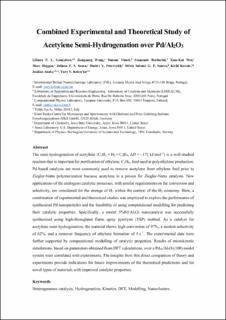| dc.contributor.author | Goncalves, Liliana PL | |
| dc.contributor.author | Wang, Jianguang | |
| dc.contributor.author | Vinati, Simone | |
| dc.contributor.author | Barborini, Emanuele | |
| dc.contributor.author | Wei, Xian-Kui | |
| dc.contributor.author | Heggen, Marc | |
| dc.contributor.author | Franco, Miguel | |
| dc.contributor.author | Sousa, Juliana PS | |
| dc.contributor.author | Petrovykh, Dmitri Y | |
| dc.contributor.author | Soares, Olívia Salomé Gonçalves Pinto | |
| dc.contributor.author | Kovnir, Kirill | |
| dc.contributor.author | Akola, Jaakko | |
| dc.contributor.author | Kolen'ko, Yury V | |
| dc.date.accessioned | 2020-05-18T08:05:24Z | |
| dc.date.available | 2020-05-18T08:05:24Z | |
| dc.date.created | 2020-01-05T20:41:46Z | |
| dc.date.issued | 2019 | |
| dc.identifier.issn | 0360-3199 | |
| dc.identifier.uri | https://hdl.handle.net/11250/2654722 | |
| dc.description.abstract | The semi-hydrogenation of acetylene (C2H2 + H2 = C2H4, ΔH = −172 kJ mol−1) is a well-studied reaction that is important for purification of ethylene, C2H4, feed used in polyethylene production. Pd-based catalysts are most commonly used to remove acetylene from ethylene feed prior to Ziegler–Natta polymerization because acetylene is a poison for Ziegler–Natta catalysts. New applications of the analogous catalytic processes, with similar requirements for the conversion and selectivity, are considered for the storage of H2 within the context of the H2 economy. Here, a combination of experimental and theoretical studies was employed to explore the performance of synthesized Pd nanoparticles and the feasibility of using computational modelling for predicting their catalytic properties. Specifically, a model 5%Pd/Al2O3 nanocatalyst was successfully synthesized using high-throughput flame spray pyrolysis (FSP) method. As a catalyst for acetylene semi-hydrogenation, the material shows high conversion of 97%, a modest selectivity of 62%, and a turnover frequency of ethylene formation of 5 s−1. The experimental data were further supported by computational modelling of catalytic properties. Results of microkinetic simulations, based on parameters obtained from DFT calculations, over a Pd30/Al2O3(100) model system were correlated with experiments. The insights from this direct comparison of theory and experiments provide indications for future improvements of the theoretical predictions and for novel types of materials with improved catalytic properties. | en_US |
| dc.language.iso | eng | en_US |
| dc.publisher | Elsevier | en_US |
| dc.rights | Attribution-NonCommercial-NoDerivatives 4.0 Internasjonal | * |
| dc.rights.uri | http://creativecommons.org/licenses/by-nc-nd/4.0/deed.no | * |
| dc.title | Combined experimental and theoretical study of acetylene semi-hydrogenation over Pd/Al <sub>2</sub> O <sub>3</sub> | en_US |
| dc.type | Peer reviewed | en_US |
| dc.type | Journal article | en_US |
| dc.description.version | acceptedVersion | en_US |
| dc.source.journal | International journal of hydrogen energy | en_US |
| dc.identifier.doi | 10.1016/j.ijhydene.2019.04.086 | |
| dc.identifier.cristin | 1766407 | |
| dc.description.localcode | © 2019. This is the authors’ accepted and refereed manuscript to the article. Locked until 9.5.2021 due to copyright restrictions. This manuscript version is made available under the CC-BY-NC-ND 4.0 license http://creativecommons.org/licenses/by-nc-nd/4.0/ " | en_US |
| cristin.unitcode | 194,66,20,0 | |
| cristin.unitname | Institutt for fysikk | |
| cristin.ispublished | true | |
| cristin.fulltext | original | |
| cristin.qualitycode | 1 | |

